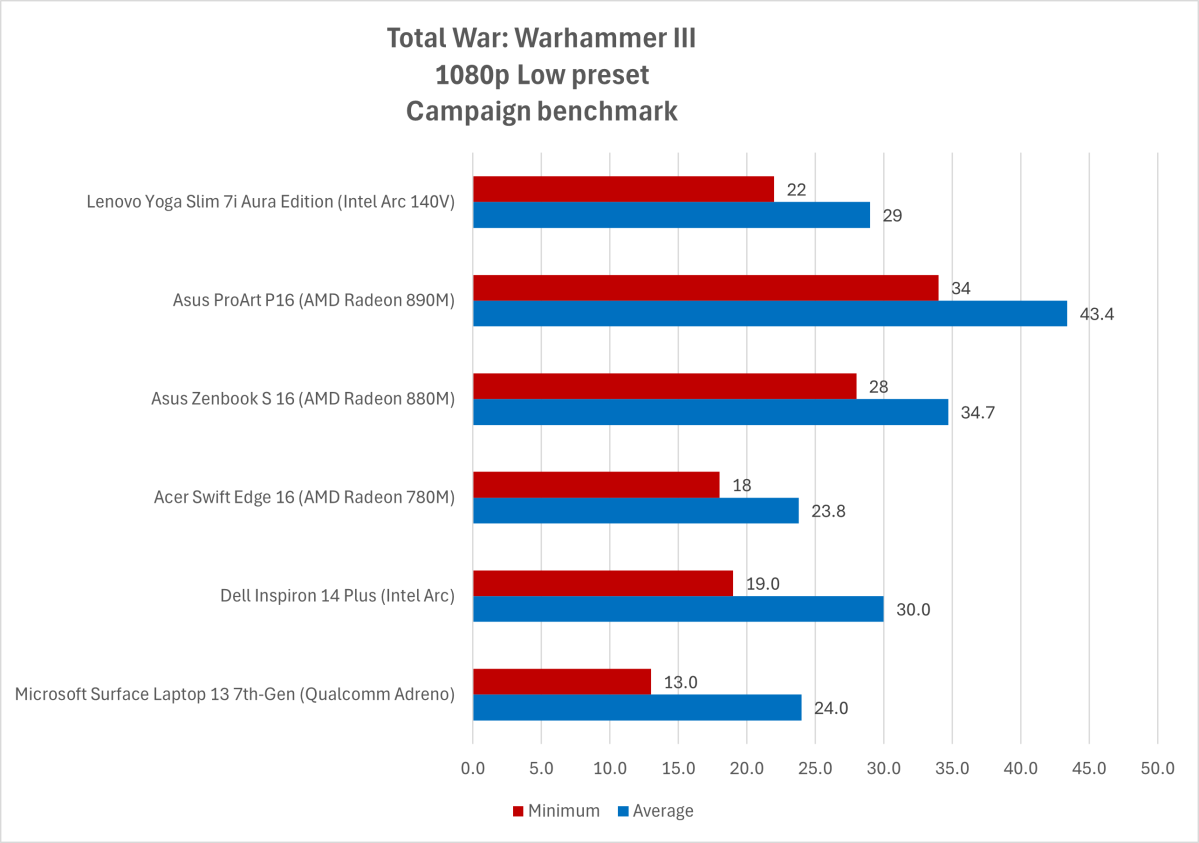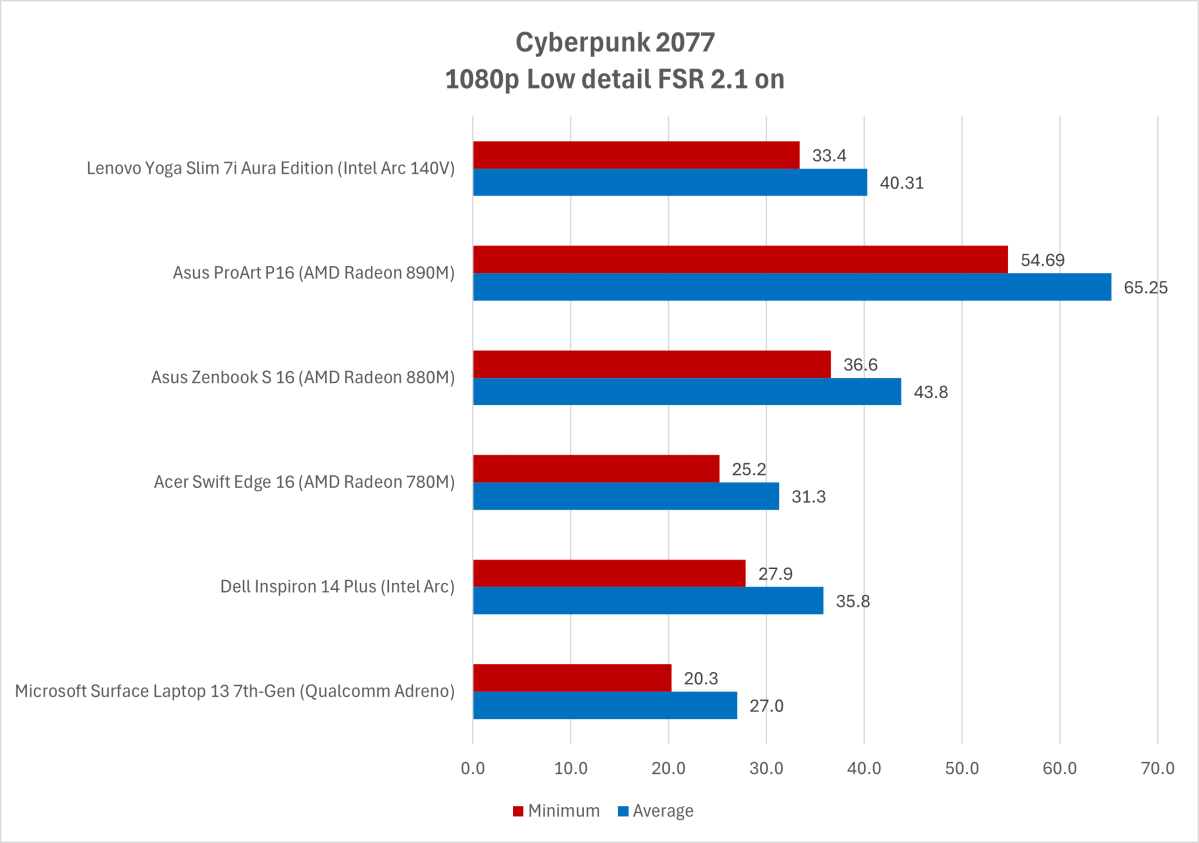Tested: Intel Arc 140V fails to dethrone AMD’s Radeon 890M
Intel’s new Lunar Lake hardware is a reflection of modern chip design.
It’s tempting to call it a “processor” or “CPU” — old habits die hard, after all — but it’s really a system-on-a-chip (SoC), both in terms of architecture and philosophy. The CPU cores are joined by integrated GPU cores, a neural processing unit (NPU), and even on-chip RAM. Also, unlike past Intel chips, Lunar Lake seems set on striking a balance between the three.
That’s keenly felt in Intel’s approach to Lunar Lake’s integrated graphics (iGPU). Building on the success of Intel Core Ultra, Intel’s new processors also offer Intel Arc — but this time around, Intel has returned to providing each iGPU a name unique to its configuration, and the best version here is the Intel Arc 140V with eight Xe Cores and a max frequency of 2.05GHz.
Meanwhile, Intel’s competition hasn’t been spinning its wheels. AMD’s latest Ryzen AI processors have their own integrated graphics updates in the form of the Radeon 880M (succeeding the well-respected Radeon 780M) and the new Radeon 890M (which clearly thumped Intel Arc in our last integrated graphics test).
So, how well does the iGPU in Intel’s Lunar Lake chips perform? Is it a minor boost over previous incarnations? Or a major update? Keep reading for our in-depth benchmark test results.
Hardware specifications for our testsThe game benchmarks below were run on a Lenovo Yoga Slim 7i Aura Edition with Intel Core Ultra 7 256V processor.
The Intel Core Ultra 7 256V is a high-end Core Ultra 7 chip for slim-and-light laptops, though more midrange in terms of overall core count and performance (as opposed to, say, the Intel Core Ultra 9 285K). This chip is a common choice for thin, light, Intel-powered laptops sold above $1,000. Cheaper laptops may offer it as an upgrade.
While the Intel Core Ultra 7 256V isn’t the most powerful SKU in Intel’s latest line-up, its iGPU looks impressive on paper. It’s badged as Intel Arc 140V, which is the best version of Arc integrated graphics in the Lunar Lake line-up. It has eight Intel Xe Cores, the same number as higher Lunar Lake SKUs. They’re also clocked at up to 1.95GHz, which is just 100MHz less than the Intel Arc 140V in the Intel Core Ultra 9 288V.
With that out of the way, let’s get to the benchmarks.
3DMarkLet’s start things off with 3DMark’s Time Spy and Night Raid tests. Time Spy is a more demanding (but still not especially punishing) benchmark while Night Raid is a less demanding benchmark meant for entry-level graphics hardware, including iGPUs.

Matthew Smith / IDG
This is a good result for Intel’s Arc 140V. It delivered a significant uplift over the AMD Radeon 880M and 780M, and it clawed out a small victory against the Dell Inspiron 14 Plus with prior-gen Intel Arc.
AMD’s Radeon 890M, however, remains an obvious rival. It blows the doors off the Intel Arc 140V in Night Raid, but is less impressive in Time Spy. That hints toward future victories from AMD Radeon 890M in less demanding games, but there’s only one way to be sure.
Onward, to the games!
Sid Meier’s Civilization VILet’s give a polite round of applause to Civilization VI. First released in October 2016, the game is now eight years old — and over the course of that journey, it has roughly doubled its active player base since the months following its launch (based on publicly available Steam stats).
With Civilization VII due out in 2025, the sun is setting on this title. But, at the moment, it’s still by far the most popular and commercially successful entry in the Civilization franchise.
It’s also a less demanding game that’s playable even when frame rates dip below 30 FPS, which makes it easy to enjoy on mid-range, thin-and-light laptops with integrated graphics.

Matthew Smith / IDG
The Intel Arc 140V disappoints here, as it delivered an average frame rate that’s essentially identical to its predecessor and well behind AMD Radeon alternatives.
It’s not all bad news, though. While average performance didn’t increase, the 1% low — an average of the lowest 1% of frames rendered, by frame time — is much higher than before. That means a smoother, more stable experience with less noticeable stutter.
Dota 2Although not often discussed in “mainstream” gaming news, Dota 2 still typically sits among the top three games on Steam and has a vibrant esports scene. It’s also the least demanding game used for this test.

Matthew Smith / IDG
Dota 2 sees another marginal uplift for the Intel Arc 140V. Though it churned out slightly better frame rates, its advantage comes down to just a handful, which is trivial in a game that averages above 100 FPS.
This leaves Intel behind AMD’s Radeon 880M and Radeon 890M graphics, though ahead of the Radeon 780M.
Final Fantasy XIVFinal Fantasy XIV is a personal favorite and remains among the most popular MMORPGs on the market.
The latest expansion, Dawntrail, brought a graphics update that noticeably improves texture quality and polygon count. That makes it somewhat challenging for iGPUs to handle, though most can deliver an average around 30 FPS or better at High (Laptop) detail.

Matthew Smith / IDG
The Intel Arc 140V once again provides a slim boost over its predecessor, though in this case the extra frames are meaningful. The minimum frame rate improved from 24 to 29 FPS (so, so close to a solid 30), while the average increased from 41 to 45 FPS.
Though these are small gains, each extra frame is more valuable when the frame rate is this low, and I consider this a perceptible boost. This impressively puts the Intel Arc 140V at the top of the pack here, defeating even the AMD Radeon 890M.
Total War: Warhammer IIIThough it sits in the same grand strategy genre as Civilization, Creative Assembly’s Total War: Warhammer III is far more demanding. It’s enough to challenge the most capable iGPUs, even at just 1080p and the Low detail preset. Intel’s Arc 140V is no exception.

Matthew Smith / IDG
This is a disappointing result for Intel. The Intel Arc 140V delivers performance hardly different from the prior version of the Intel Arc iGPU. And, more importantly, gameplay is at times extremely choppy, as the frame rate dips as low as 22 FPS.
AMD’s Radeon 880M and Radeon 890M both notch wins here as both deliver a much more playable experience, and the Radeon 890M elevates the minimum frame rate above the crucial 30 FPS line.
The Elder Scrolls V: SkyrimThough over 10 years old at this point, The Elder Scrolls V: Skyrim is a game that keeps on giving. It remains popular and, thanks to graphical upgrades in the Special Edition, it’s still somewhat demanding for iGPUs when played at 1080p resolution and High detail.

Matthew Smith / IDG
This is a mixed result. Intel’s Arc 140V doesn’t provide an improvement over the prior version of Intel Arc, which is a shame because this game is close to averaging over 60 frames per second at 1080p and High detail.
However, the Intel Arc 140V still compares well against AMD’s Radeon 880M and Radeon 890M. All three provide a similar experience, while AMD’s older Radeon 780M and Qualcomm’s Adreno are left far behind.
Cyberpunk 2077We finish off with Cyberpunk 2077, a notoriously demanding game that, despite a lackluster launch, has roared back to popularity in part thanks to its visually stunning and immersive world.

Matthew Smith / IDG
This is a good result for the Intel Arc 140V, which delivers a noticeable improvement over its predecessor. Lifting the average from 35 to 40 FPS isn’t a night-and-day difference, but it does feel a tad smoother overall as the minimum frame rate now exceeds 30 FPS.
Because of this, the Intel Arc 140V is also more competitive with AMD’s Radeon 880M. AMD still ekes out a win, but the two performed similarly and the latter only gets away with an advantage of just 3 FPS. That’s still meaningful when a game’s average frame rate is this low, but the difference is more subtle here.
The Intel Arc 140V’s performance verdictThe Intel Arc 140V integrated graphics in the Intel Core Ultra 7 256V provides a modest, though sometimes noticeable, improvement over prior Intel Arc incarnations. Whether it makes a big difference or not really comes down to the individual game.
In our tests, the Intel Arc 140V saw its most favorable results in Cyberpunk 2077 and Final Fantasy XIV, where it provided gains that, although small, made each game feel more fluid. That’s mainly due to bumps in minimum frame rates that were now less likely to dip below 30 FPS.
In other games, like Civilization VI and Total War: Warhammer III, the Intel Arc 140V delivered little or no improvement. This wasn’t a problem in Civilization VI (which is more than playable), but it was a problem in Total War: Warhammer III (which is choppy on Intel’s Arc 140V).
How does the Intel Arc 140V compare to AMD’s Radeon 880M and Radeon 890M? Both the Intel Arc 140V and AMD Radeon 880M are neck-and-neck, and there isn’t much to recommend one over the other. Game optimization can be a factor — Civilization VI definitely favors AMD hardware, for example — but on balance, they’re comparable. AMD’s Radeon 890M is still king, but again it depends on the game. Some show a huge boost on the Radeon 890M while others nose ahead by a bit.
In summary, the Intel Arc 140V is a minor update over prior Intel Arc integrated graphics, but Intel remains competitive with AMD and the Intel Arc 140V is more than capable of playing many older and less demanding games at acceptable frame rates. While Intel’s Arc 140V isn’t ideal for Total War: Warhammer III or Cyberpunk 2077, it’s still powerful enough to run Civilization VI and Dota 2 just fine.
